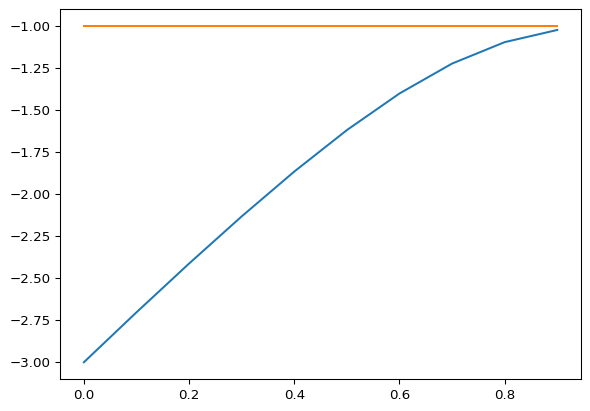N = 3 # 4 qubit systemAQC in practice
We will make a simple example so that the formalism of this algorithm is clear to everyone. We will need for this exercise:
- A initial Hamiltonian and its ground state
- A final Hamiltonian
- A Scheduling function that governs the evolution and mixture between the two
So let’s start by selecting our initial Hamiltonian:
\[ H_{init} = - \sum_i^N \sigma_i^x \]
import numpy as np
sigma_x = np.matrix([[0, 1],
[1, 0]])
H_init = 0
for j in range(N):
H_init += -1.0 * np.kron( np.kron(np.identity(2**j), sigma_x), np.identity(2**(N-j-1)) )
H_initmatrix([[ 0., -1., -1., 0., -1., 0., 0., 0.],
[-1., 0., 0., -1., 0., -1., 0., 0.],
[-1., 0., 0., -1., 0., 0., -1., 0.],
[ 0., -1., -1., 0., 0., 0., 0., -1.],
[-1., 0., 0., 0., 0., -1., -1., 0.],
[ 0., -1., 0., 0., -1., 0., 0., -1.],
[ 0., 0., -1., 0., -1., 0., 0., -1.],
[ 0., 0., 0., -1., 0., -1., -1., 0.]])Now we will use a couple of functions to compute the Eigenspectra (set of eigenvalues for a given Hamiltonian) and the ground-state (minimum energy state).
from math import sqrt
from numpy.linalg import eig
def get_eigenspectra(h_mat):
"""
Computes the eigenspectra
"""
evals, evecs = eig(h_mat)
sort_index = np.argsort(evals)
return evals [sort_index], evecs[:, sort_index]
def get_gs(h_mat):
""" Computes the ground state """
evals, evecs = eig(h_mat)
sort_index = np.argsort(evals)
stat_gs = evecs[:, sort_index[0]]
gs_val = evals[sort_index[0]]
num = 1
for idx in sort_index[1:]:
if evals[idx] == gs_val:
stat_gs += evecs[:, idx]
num += 1
else:
break
return np.dot((1/sqrt(num)), stat_gs)So, by computing the ground state of our initial Hamiltonian we can check that it is the superposition of all possible states with equal probability.
get_gs(H_init)matrix([[-0.35355339],
[-0.35355339],
[-0.35355339],
[-0.35355339],
[-0.35355339],
[-0.35355339],
[-0.35355339],
[-0.35355339]])Now for our target Hamiltonian we will select a random instance of the Ising model that looks like:
\[ H_{problem} = \sum_j^N J_{j,j+1}\sigma_j^z\sigma_{j+1}^z \]
J = -1
sigma_z = np.matrix([[1, 0],
[0, -1]])
H_problem = 0
for i in range(N-1):
H_problem = J* np.kron( np.kron(np.identity(2**i), sigma_z), np.identity(2**(N-i-1)) ) * np.kron( np.kron(np.identity(2**(i+1)), sigma_z), np.identity(2**(N-(i+1)-1)) )
H_problemmatrix([[-1., 0., 0., 0., 0., 0., 0., 0.],
[ 0., 1., 0., 0., 0., 0., 0., 0.],
[ 0., 0., 1., 0., 0., 0., 0., 0.],
[ 0., 0., 0., -1., 0., 0., 0., 0.],
[ 0., 0., 0., 0., -1., 0., 0., 0.],
[ 0., 0., 0., 0., 0., 1., 0., 0.],
[ 0., 0., 0., 0., 0., 0., 1., 0.],
[ 0., 0., 0., 0., 0., 0., 0., -1.]])get_gs(H_problem)matrix([[0.5],
[0. ],
[0. ],
[0.5],
[0.5],
[0. ],
[0. ],
[0.5]])We can see our Ising model has a ground state looking like
\[ |\psi\rangle = \frac{1}{2}|000\rangle + \frac{1}{2}|011\rangle + \frac{1}{2}|100\rangle + \frac{1}{2}|111\rangle. \]
Now we would only need to define a scheduling function to mix both Hamiltonians. Just for simplicity we will use a single scheduling function \(\lambda(t)\) and use its complementary for the decaying of the initial Hamiltonian.
\[ H(t) = (1-\lambda(t))H_{init} + \lambda(t)H_{problem} \]
e0 = []
e1 = []
time_range = np.arange(0.0, 1.0, 0.1)
for lambda_t in time_range:
H = (1-lambda_t)*H_init + lambda_t*H_problem
vals, stats = get_eigenspectra(H)
e0.append(vals[0])
e1.append(vals[1])import matplotlib.pyplot as plt
plt.plot(time_range, e0, time_range, e1)
plt.show()
plt.plot(np.subtract(e1,e0))
plt.show()
stats[:, 0]matrix([[0.49701447],
[0.05455839],
[0.05455839],
[0.49701447],
[0.49701447],
[0.05455839],
[0.05455839],
[0.49701447]])There you go, the obtained state corresponds with the desired
\[ |\psi\rangle = \frac{1}{2}|000\rangle + \frac{1}{2}|011\rangle + \frac{1}{2}|100\rangle + \frac{1}{2}|111\rangle. \]
up to a precision.